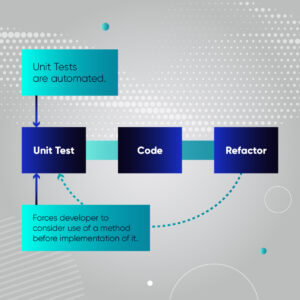The role of testing in software development
TDD has been around for over two decades, and although it was associated with extreme programming at first, it has grown in popularity as an outstanding approach to improving the productivity of development teams and to generate better code, in recent years.
We know how enormous gains companies can make by the adaptation of test driven development. Therefore, in the spirit of weCan’s core values, we are firmly committed to using TDD and are moving towards its application in all our projects, in order to deliver more cost-efficient and higher quality products to our customers.
But how does it work exactly and what are the precise benefits of its application? Read our article and get to know more!
Understanding test driven development
Test driven development is a software development process that relies on the repetition of a short development pattern called  “red-green-refactor” cycle. The idea behind the methodology is to write tests in order to specify and validate the functionality of the code before it is actually written.
“red-green-refactor” cycle. The idea behind the methodology is to write tests in order to specify and validate the functionality of the code before it is actually written.
The key distinguishing factor between TDD and traditional programming methods is that TDD focuses on cyclical testing, while the traditional development process is linear. In the latter case the code is written first and all the tests are run at the end of the development process.
The test-then-code approach of TDD, however, works differently. In this instance automated unit tests are written before the code, which encourages developers to consider how the software will be used and what design it needs to have to provide the expected usability. The developer first writes an automated test case that defines a desired improvement or new function, then produces the minimum amount of code to pass that test, and then refactors the new code to required standards.
The top 3 benefits of TDD
It is compatible with Agile methodology
The test driven development process ensures that the quality of the code comes first, while Agile focuses on the overall development process. The TDD approach therefore has become increasingly popular in the Agile software development niche, since combining the benefits of both methodologies guarantee the development of high-quality software because of the test-then-code approach and short development cycles.
Prevents bugs early on in the development process
As code bases increase in size, they become progressively more complex and hard to alter. These larger codebases are at heightened risk when using the traditional “test at the end” approach, since errors are much harder to find. However, by adding functionality to the code as it is written, it ensures that each section of the software operates properly as it progresses.
One of the primary benefits of this approach are fewer bugs and errors in the code, which means that developers will spend less time fixing them than if they would use other programming methodologies. TDD therefore produces higher overall test coverage and a better quality of the final product.
Project costs decrease, ROI increases
With the introduction of the TDD concept, the general cost of product development can be effectively reduced as maintenance and bug fixes require less time and effort.
However, it is important to emphasize that cost saving will occur over the lifecycle of the product and not short term. Since additional testing costs are associated with TDD projects, in the short term test driven development solutions will almost always have a higher price. But without the “test-first” approach, most projects become expensive in the long run. In addition, without test code coverage and built-in testing standards, there is a higher risk of failure, since various bugs and technical issues can quickly add to the product’s budget.
In essence, TDD can reduce time to market and improve the overall cost of the project in the long run, while also increasing quality and reducing the risk of defects. This is also supported by research, involving engineering teams at Microsoft and IBM, which concluded “the pre-release defect density of the four products decreased between 40% and 90% relative to similar projects that did not use the TDD practice.” The result is lower costs for developing custom marketplaces, SaaS products and other custom solutions.
Why we stand by TDD
 In today’s competitive software market, where app availability is one of the key factors that determine success, TDD is a major advantage as it enables functional code for end-users in a short time span.
In today’s competitive software market, where app availability is one of the key factors that determine success, TDD is a major advantage as it enables functional code for end-users in a short time span.
In weCan’s experience, businesses can immensely benefit from the use of TDD, not only because it shortens the development time to market, but also because instead of fighting against bugs, organisations can focus on accomplishing goals and create a product that drives tangible business results. For example, a case study involving Microsoft and IBM teams of software engineers concluded that the “teams experienced a 15-35% increase in initial development time” when they used the TDD technique.
At weCan, we know how to create quality software fast, thus we recommend using test driven development to developers and management alike.
